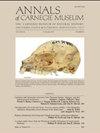A New Genus of Cylindrodontid Rodent from the Chadronian (Late Eocene) of Southwestern Montana and a Reassessment of the Genus Pseudocylindrodon Burke, 1935
IF 0.9
4区 地球科学
Q4 PALEONTOLOGY
引用次数: 4
Abstract
ABSTRACT The cylindrodontid rodent Pseudocylindrodon Burke, 1935, formerly included seven named species, but is here restricted to the type species P. neglectus Burke, 1935, two additional North. American species (P. citofluminis Storer, 1984, and P. lateriviae Storer, 1988), and the Asian species P. mongolicus Kowalski, 1974. The other three species previously assigned to Pseudocylindrodon are here referred to the new genus Dolocylindrodon: D. medius (Burke, 1938), D. tobeyi (Black, 1970), and D. texanus (Wood, 1974) based on a combination of cranial and dental morphology. Two new species of Dolocylindrodon are named from the Chadronian part of the Climbing. Arrow Formation of southwestern Montana: Dolocylindrodon vukae (type species of the genus) and Dolocylindrodon rahnensis. Additional specimens of D. medius from the early Chadronian McCarty's Mountain fauna of Montana are briefly discussed. The recognition of a new genus and two new species of cylindrodonts increases the known diversity of this family to 14 recognized species included in five genera during the North .American Chadronian, the time of greatest diversity of the family. Dolocylindrodon is viewed as a primitive member of the Cylindrodontinae that attained higher-crowned teeth independent of the more hypsodont Cylindrodon Douglass, 1901.美国蒙大拿州西南部夏德龙世(晚始新世)圆柱齿啮齿动物新属及伪圆柱齿啮齿动物属的再鉴定
柱状齿啮齿动物pseudoylindrodon Burke, 1935,以前包括7个已命名种,但这里仅限于模式种P. ignoectus Burke, 1935,另外2个北种。美洲种(P. citofluminis Storer, 1984年,和P. lateriviae Storer, 1988年)和亚洲种P. mongolicus Kowalski, 1974年。另外三个以前被归入Pseudocylindrodon的物种在这里被称为Dolocylindrodon新属:D. medius (Burke, 1938), D. tobeyi (Black, 1970)和D. texanus (Wood, 1974)。在攀登带的查德龙期部分命名了两种新的Dolocylindrodon。蒙大拿西南部的箭形构造:Dolocylindrodon vukae(属的模式种)和Dolocylindrodon rahnensis。本文简要讨论了蒙大拿州早查德龙世麦卡蒂山动物群中的其他中棘龙标本。新发现的一属和两种圆柱形植物使该科的已知多样性增加到14种,包括在该科多样性最丰富的北美查德龙期的5属中。Dolocylindrodon被认为是圆柱齿科的一个原始成员,它获得了更高冠的牙齿,独立于更多的下齿圆柱齿。
本文章由计算机程序翻译,如有差异,请以英文原文为准。
求助全文
约1分钟内获得全文
求助全文
来源期刊

Annals of Carnegie Museum
综合性期刊-动物学
CiteScore
2.50
自引率
18.20%
发文量
4
审稿时长
>12 weeks
期刊介绍:
Annals of Carnegie Museum is a quarterly journal that publishes peer-reviewed short and medium-length original scientific contributions in organismal biology, earth sciences, and anthropology, in 40 by 52.5 pica format (168 by 220 mm or 6-5/8 by 8-5/8 inches). Subject matter must be relevant to Carnegie Museum of Natural History scientific sections or Powdermill Nature Reserve (PNR), preferably with connection to the Carnegie collection and/or personnel. Carnegie Museum staff and research associates receive publication priority, but others are encouraged to submit papers, especially those manuscripts explicitly based on the Carnegie collection.
 求助内容:
求助内容: 应助结果提醒方式:
应助结果提醒方式:


